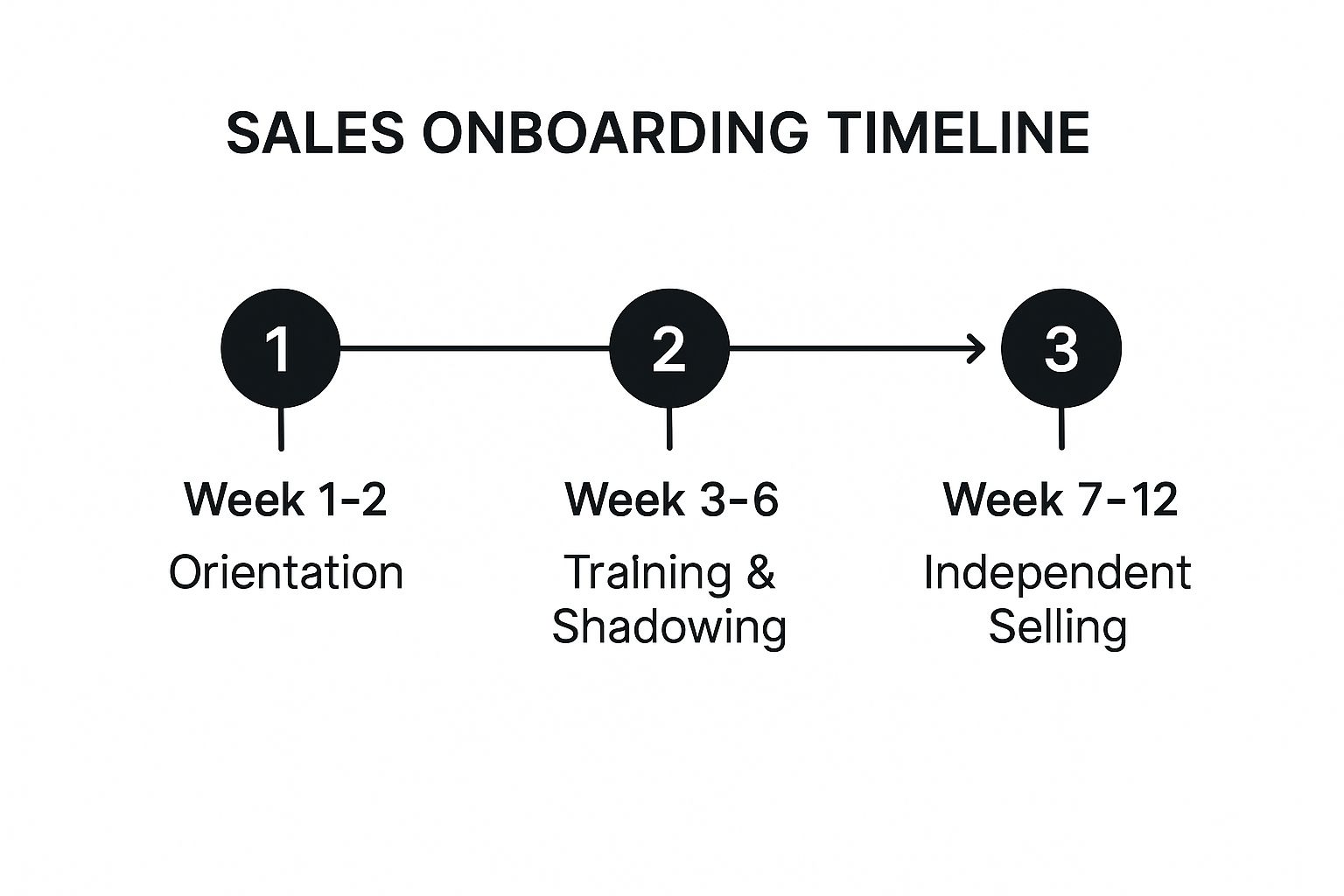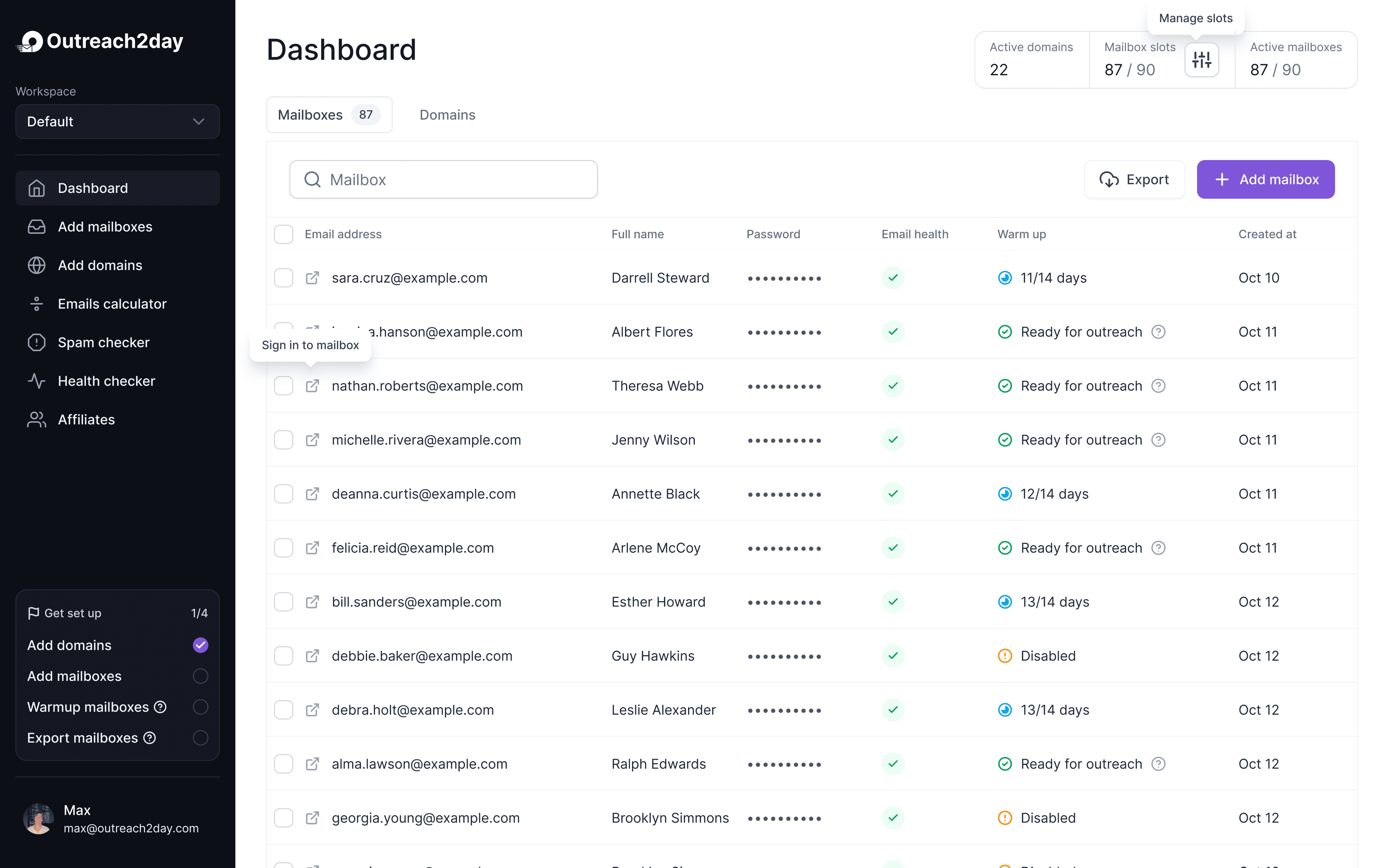Sales Enablement Best Practices: Boost Your Pipeline in 2025
Oct 16, 2025

Sales enablement has shifted from a support role to a strategic force in high-growth sales organizations, yet many teams fail to go beyond basic advice, affecting pipeline velocity and revenue. This guide offers a practical blueprint for implementing effective sales enablement practices.
Focusing on two main objectives—enhancing email outreach and boosting pipeline growth—you'll discover how to create centralized content hubs, develop buyer-centric playbooks, and use technology to amplify top performers. We discuss aligning sales and marketing through a unified revenue operations framework and utilizing data-driven coaching to enhance team performance.
From structured onboarding to real-time learning, each practice aims for immediate impact, transforming sales enablement into a reliable revenue driver. This article outlines the steps to equip sellers with the right content, training, and tools precisely when needed.
1. Develop a Centralized Content Management System
A key practice in sales enablement is establishing a centralized content management system (CMS) that serves as the single source for all essential sales materials, such as case studies and email templates. This consolidation prevents productivity loss from searching through outdated or scattered resources. It ensures all team members access current, consistent, and compliant content, turning it into a strategic asset.
Real-World Impact
Leading companies show the benefits of content centralization. DocuSign consolidated 15 repositories into one, increasing sales productivity by about 25%. SAP used Highspot to centralize materials across 100+ countries, improving content findability by 60%. This ensures global teams have relevant assets readily available, leading to quicker deal cycles and more effective sales conversations.
How to Implement This Practice
Audit and Purge: Conduct a thorough content audit to identify existing assets, their usage, and outdated or underperforming items.
Establish Governance: Implement a strict naming convention and folder structure from the outset. Designate content owners for each category to ensure quality and relevance.
CRM Integration: Link your CMS to your CRM (e.g., Salesforce, HubSpot) for contextual content recommendations based on deal stage, industry, or persona.
Feedback Loop: Create a process for sales reps to request new content or suggest improvements, ensuring the library adapts to market needs.
2. Create Buyer-Centric Sales Playbooks
Developing buyer-centric sales playbooks is a key sales enablement practice. These guides align the sales process with the buyer's journey, offering messaging, objection handling, and value-focused tactics for each decision-making stage. This approach emphasizes "why they buy" over "what we sell," ensuring interactions are relevant and helpful. It also standardizes excellence by codifying top performers' habits for the whole team.
Real-World Impact
Buyer-centric playbooks have proven strategic value. LinkedIn Sales Solutions increased their average enterprise deal size by 35% using these playbooks. HubSpot scaled effectively to over 1,000 sales reps with a playbook-driven approach. These examples demonstrate how clear playbooks enhance consistency and drive revenue growth.
How to Implement This Practice
Engage Top Performers: Work with your leading sales reps to document their effective strategies and customer communication. Their insights are key to a successful playbook.
Align with the Buyer's Journey: Organize the playbook according to the customer's path from awareness to decision, highlighting key questions, challenges, and objectives at each stage.
Keep It Updated: Regularly revise the playbook to refresh messaging, incorporate new competitive insights, and adjust strategies based on win-loss data.
Ensure Accessibility: Develop modular content that is easy to access and apply, ensuring the playbook is mobile-friendly for quick use during customer interactions.
3. Implement Continuous Sales Training and Coaching Programs
Effective sales enablement practices extend beyond onboarding by implementing ongoing training and coaching. This continuous development adapts to market changes and reinforces skills, preventing reps from forgetting up to 84% of training content within 90 days. Programs like personalized coaching, peer learning, and microlearning ensure knowledge retention, turning training into a key driver of team performance and revenue growth.
Real-World Impact
Top technology companies demonstrate the direct ROI of this commitment. Microsoft saw a 25% increase in win rates for complex deals through a continuous learning program. During hypergrowth, Zoom employed microlearning to sustain productivity while expanding its workforce from 500 to 5,000. Likewise, Salesforce's Trailhead platform gamifies learning, with over 50 million badges earned, promoting ongoing skill development.
How to Implement This Practice
Establish a Coaching Schedule: Implement a regular plan for development, such as weekly call reviews, monthly workshops, and quarterly product certifications.
Use Conversation Analysis: Employ tools like Gong or Chorus.ai to examine sales calls, gaining insights for targeted coaching based on specific call moments.
Implement the 70-20-10 Model: Focus 70% on hands-on experience, 20% on peer learning, and 10% on structured training.
Develop a Best-Practice Library: Create a collection of recordings from top reps, accessible for quick learning before important calls.
4. Align Sales and Marketing Through Revenue Operations
One impactful sales enablement practice is transitioning to a unified Revenue Operations (RevOps) model, aligning sales, marketing, and customer success to maximize revenue. This model integrates technology, processes, and data across the customer lifecycle, ensuring a seamless buyer journey and optimizing the entire revenue engine.
Real-World Impact
High-growth companies like Snowflake and Drift exemplify the benefits of RevOps. Snowflake's alignment of sales and marketing significantly contributed to its major IPO, while Drift's RevOps approach improved lead qualification and reduced their sales cycle by 33%, highlighting the effectiveness of unified go-to-market teams.
How to Implement This Practice
Set Unified Revenue Goals: Focus on combined revenue targets rather than individual MQL or quota objectives to encourage collaboration.
Establish Clear SLAs: Document agreements where marketing delivers qualified leads and sales follows up within a specified timeframe.
Integrate Technology Systems: Connect key systems like CRM, marketing automation, and customer success software for a unified customer data source.
Conduct Regular Meetings: Hold weekly or bi-weekly sessions for sales and marketing to discuss pipeline status and campaign insights.
Collaboratively Map the Buyer Journey: Define each stage of the customer journey together, assigning responsibility to ensure a seamless experience.
5. Leverage Data and Analytics for Sales Intelligence
A key sales enablement practice is the strategic use of data and analytics. By employing business intelligence tools and AI, sales teams gain actionable insights. Analyzing buyer behavior and content performance shifts sales processes from intuition-based to predictive. This data-driven approach offers prescriptive recommendations, enhancing deal advancement, improving forecast accuracy, and providing a competitive edge.
Real-World Impact
Companies that use data effectively experience significant benefits. Adobe improved its forecast accuracy from 75% to 95% by using Clari for deal intelligence. Similarly, Slack employs Gong.io for analyzing sales calls, identifying top performers' behaviors, and replicating these strategies across teams. These cases demonstrate how analytics boost win rates and ensure predictable revenue.
Implementing This Approach
Focus on Key Metrics: Avoid complex dashboards by initially tracking essential metrics like content engagement, win/loss reasons, and lead response times.
Ensure Data Accuracy: Inaccurate data skews insights. Use automation and conduct regular CRM audits to maintain data integrity.
Actionable Insights: Go beyond data presentation; guide reps on utilizing insights, such as using predictive lead scoring for prioritizing promising prospects. For more on this, visit our B2B lead nurturing strategies guide.
Monitor Content Engagement: Evaluate which content is viewed and shared to refine your strategy based on buyer engagement.
6. Optimize Sales Onboarding with Structured Ramp Programs
A key sales enablement practice is transitioning from ad-hoc onboarding to a structured, time-bound program. This method offers new hires a consistent path to productivity, focusing on product knowledge, sales techniques, systems proficiency, and practical experience. Establishing milestones and certification gates transforms the initial months from overwhelming to empowering.
Such a program ensures consistency and speeds up new sellers' journey to becoming confident, quota-carrying contributors. Research shows that formal onboarding accelerates new hires' productivity by 3-4 months, boosting revenue and reducing early attrition.
This timeline illustrates a typical three-phase structure for a 12-week sales onboarding program.

This phased approach systematically builds a new hire's skills, moving from foundational knowledge to guided practice and finally to autonomous execution.
Real-World Impact
Top-performing sales organizations endorse this methodology. HubSpot's 'Sales Bootcamp' accelerates new reps to full productivity in three months, compared to the industry's six. Workday's structured program cut ramp time from nine months to 4.5, boosting first-year quota attainment by 30%. These demonstrate that a strong onboarding framework yields measurable returns.
Implementing This Practice
Set 30-60-90 Day Goals: Establish clear outcomes for each onboarding phase, such as product certification in the first 30 days and closing a deal by day 90.
Assign a Peer Mentor: Provide new hires with a peer mentor for process questions and cultural integration.
Require Practice Before Performance: Ensure new reps pass role-playing certifications before customer interactions.
Employ Spaced Repetition: Reinforce key concepts over time to enhance long-term retention.
Collect Cohort Feedback: Gather feedback at the end of each cohort's ramp period to improve the onboarding experience.
7. Enable Just-in-Time Learning and Microlearning
One effective sales enablement practice is shifting from extensive training sessions to a just-in-time learning model. This method provides sales teams with concise, relevant information precisely when needed, such as before a call, during a deal stage, or when facing objections. Microlearning modules of 3-7 minutes enhance immediate application and improve retention.
Traditional training often results in poor recall, while learning in real-time ensures the information is timely and actionable, integrating training into the sales workflow and enabling reps to adapt successfully.
Real-World Impact
Leading companies achieve notable results with microlearning. Google uses "Whisper Courses" via nudge emails, achieving 50% higher completion rates. Cisco offers three-minute product demos on-demand via a video platform. UPS trained 9,500 drivers in 30 days, reducing training time by 60%. These examples show how targeted knowledge delivery boosts performance and efficiency.
How to Implement This Practice
Focus on Single Concepts: Limit learning modules to under five minutes, concentrating on a specific skill, product feature, or objection-handling technique.
Contextual Learning Triggers: Link your learning platform with your CRM to deliver content based on the deal stage, such as showing competitor guides when competitors are mentioned.
Scenario-Based Library: Categorize content by sales scenarios like buyer personas or industry challenges, using clear titles and tags for easy searchability.
Capture Top Performers' Insights: Record brief video tips from top reps on handling tough questions or crafting messages. These insights are valuable microlearning tools, useful across various platforms.
8. Implement Sales and Marketing Content Feedback Loops
One key sales enablement practice is establishing a feedback loop between sales and marketing teams. This formal communication allows sales to report on content effectiveness, missing assets, and performance in real interactions. It bridges the gap between content creation and use, ensuring marketing develops assets that sales will utilize to close deals.
This collaboration shifts content from a one-way message to a dynamic resource. Marketing gains insights into customer needs, while sales receives targeted collateral. The result is a more efficient content engine that accelerates the sales pipeline.
Real-World Impact
Leading companies demonstrate the effectiveness of structured feedback. For example, Salesforce created a 'content council' that reduced unused content by 60%. Adobe re-evaluated its strategy after finding 70% of content was unused, and Schneider Electric's content request portal cut asset creation time from six weeks to five days.
How to Implement This Practice
Formal Request Process: Set up a portal for reps to request new content, with clear SLAs for responses and creation times.
Monthly Content Roundtables: Hold regular meetings between sales and marketing to review content performance and prioritize requests.
Integrate Feedback into CMS: Use a rating system and comments within your CMS for immediate feedback on assets.
Connect Content to Outcomes: Track content usage in your CRM to identify high-performing assets and replicate their success.
9. Use Conversation Intelligence to Scale Best Practices
Implementing conversation intelligence is a crucial sales enablement practice for enhancing performance. These platforms employ AI to record, transcribe, and analyze sales interactions, identifying behaviors that distinguish top performers. This approach offers data-driven insights into effective communication strategies, competitor positioning, and successful objection-handling techniques.
By examining each interaction, the "tribal knowledge" of top reps can be systematically shared, turning individual talent into a scalable process. This ensures that successful strategies are adopted by the entire sales team.
Real-World Impact
Data from conversation intelligence outlines a path to improved win rates. For instance, Gong.io helped Zoom discover that their most successful reps asked significantly more questions, leading to a revised focus on discovery in training. Slack, using Chorus.ai, found that discussing pricing early reduced win rates, prompting changes in their sales approach. These cases demonstrate that conversation analysis provides essential data for impactful changes.
How to Implement This Practice
Ensure Transparency and Buy-In: Communicate the tool's purpose as a development resource to build trust and encourage usage.
Create "Greatest Hits" Playlists: Develop a library of effective call snippets for training and onboarding.
Set Up Strategic Alerts: Use the platform to flag important keywords for timely competitive insights.
Focus on Positive Coaching: Highlight and reinforce successful behaviors to encourage more of the same.
Sales Enablement Best Practices Comparison
Item Title | Implementation Complexity 🔄 | Resource Requirements ⚡ | Expected Outcomes 📊 | Ideal Use Cases 💡 | Key Advantages ⭐ |
|---|---|---|---|---|---|
Develop a Centralized Content Management System | Medium: Platform setup, training, and governance | Moderate: Platform investment and maintenance | Improve content findability, brand consistency | Sales content organization and onboarding | Reduces content search time; ensures message alignment |
Create Buyer-Centric Sales Playbooks | High: Requires ongoing updates and customization | Moderate to High: Content creation and reviews | Accelerate ramp-up; improve win rates | Aligning sales tactics with buyer journey | Standardizes best practices; scalable growth |
Implement Continuous Sales Training and Coaching | High: Ongoing scheduling, coaching skill needed | High: Manager time and training platform costs | Increase quota attainment; build adaptive skills | Continuous skill development and coaching | Improves retention; fosters culture of improvement |
Align Sales and Marketing Through Revenue Operations | High: Organizational change and process design | High: Tech stack integration and change mgmt | Improve revenue growth and forecast accuracy | Cross-functional alignment in revenue generation | Eliminates silos; improves lead quality and conversion |
Leverage Data and Analytics for Sales Intelligence | High: Data quality and analytics platform setup | High: Analytics tools and data management | Improve forecast accuracy; identify risk early | Predictive sales insights and prioritization | Reduces bias; actionable sales intelligence |
Optimize Sales Onboarding with Structured Ramp Programs | Medium to High: Program design and updates | Moderate: Training resources and mentoring | Reduce ramp time; increase retention | New hire onboarding and certification | Consistent productivity; confidence building |
Enable Just-in-Time Learning and Microlearning | Medium: Content creation and platform integration | Moderate: Content curation and technology | High knowledge retention; reduced time away from selling | Quick skill refreshers during sales cycles | Mobile access; immediate application |
Implement Sales and Marketing Content Feedback Loops | Medium: Process establishment and ongoing mgmt | Moderate: Coordination and analytics resources | Increase content usage; improve content relevance | Sales-marketing collaboration for content optimization | Aligns content to real needs; improves utilization |
Use Conversation Intelligence to Scale Best Practices | High: AI tools setup and compliance management | High: AI platforms and privacy compliance | Increase win rates; objective coaching insights | Call analysis and behavioral coaching | Captures winning behaviors; reduces review time |
Putting Enablement into Action: Your Path to Pipeline Dominance
Mastering sales enablement is an ongoing commitment to strategic improvement. We've identified nine key pillars, from establishing a centralized content hub and buyer-focused playbooks to continuous coaching and using conversation insights. Together, these elements create a cohesive system that enhances your sales team's efficiency and success.
Transforming from a reactive support role to a proactive revenue generator starts with a well-placed step. Avoid overhauling everything at once. Instead, target one or two areas offering the greatest immediate impact, such as streamlining onboarding to reduce ramp time or creating a strong feedback loop between sales and marketing to refine messaging.
Focusing on impactful, incremental changes builds momentum and quickly demonstrates value. As systems mature, they strengthen each other, creating a flywheel effect. A well-trained team uses centralized content effectively, and conversation insights guide playbooks and coaching. This integrated approach embodies modern sales enablement best practices.
Blueprint for Sustainable Growth
The aim is to empower sellers to perform at their best by providing the right content, training, and tools when needed. It's about removing friction and using data-driven insights. With a top-tier enablement framework, you enhance quota attainment and establish a sustainable competitive edge for predictable revenue growth.
This transformation demands a cultural shift towards continuous learning and data-driven decisions. The strategies in this article offer a blueprint for that shift. Achieving pipeline success involves implementing proven strategies consistently.
A vital part of any outreach-focused strategy is ensuring your messages reach their targets. Outreach Today eliminates technical barriers to high deliverability through automation. Discover how our platform supports successful outreach campaigns at Outreach Today.
Setup your outreach in
3 minutes. Literally.
Add or transfer domains from other platforms, set up mailboxes, and initiate warming or export processes

